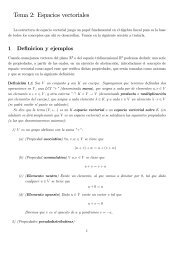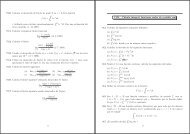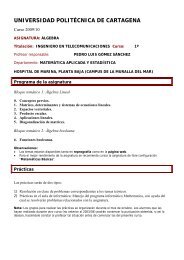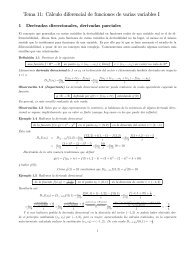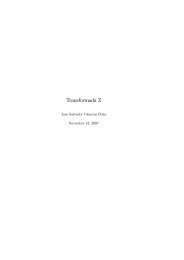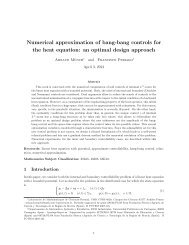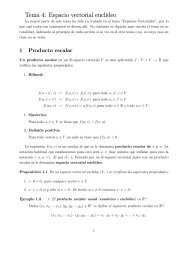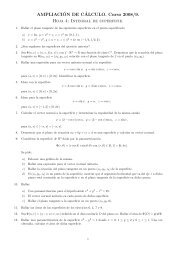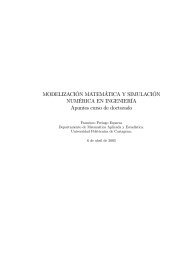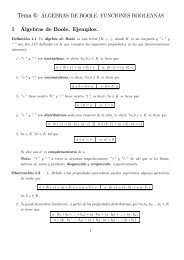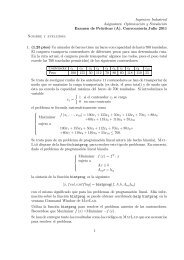Tema 9: Integral de Riemann
Tema 9: Integral de Riemann
Tema 9: Integral de Riemann
You also want an ePaper? Increase the reach of your titles
YUMPU automatically turns print PDFs into web optimized ePapers that Google loves.
<strong>Tema</strong> 9: <strong>Integral</strong> <strong>de</strong> <strong>Riemann</strong><br />
1 <strong>Integral</strong>es <strong>de</strong>finidas<br />
1.1 <strong>Integral</strong> y propieda<strong>de</strong>s<br />
Los conceptos <strong>de</strong> integral y <strong>de</strong> función integrable (en el sentido <strong>de</strong> <strong>Riemann</strong>) son un poco complejos<br />
y no lo vamos a tratar con mucho rigor. Expongamos aquí una i<strong>de</strong>a intuitiva <strong>de</strong>l concepto:<br />
Dada una función (en principio) positiva<br />
f :[a, b] → R<br />
preten<strong>de</strong>mos analizar el área A <strong>de</strong>l recinto limitado por la curva y = f(x) (y el eje OX)enelintervalo<br />
<strong>de</strong> <strong>de</strong>finición [a, b].<br />
Tomamos una ”partición” <strong>de</strong>l intervalo. Esto consiste en un conjunto finito or<strong>de</strong>nado<br />
{a = x 0
un número finito, en los cuáles existen los límites laterales <strong>de</strong> la función y son finitos, también la<br />
función es integrable en [a, b]. Cuando una función sea integrable en un intervalo [a, b] <strong>de</strong>nominaremos<br />
integral <strong>de</strong>finida (integral <strong>de</strong> <strong>Riemann</strong>, o simplemente integral) <strong>de</strong>f en dicho intervalo, y lo<br />
<strong>de</strong>notaremos por<br />
Z b<br />
f<br />
opor<br />
Z b<br />
f(x)dx,<br />
(o en vez <strong>de</strong> x otra variable),<br />
a<br />
a<br />
a un número, que a la postre representará geométricamente el área A, yqueenlosucesivoiremos<br />
diciendo cómo calcular.<br />
Interpretación <strong>de</strong> la integral<br />
Vamos a relacionar esta parte con la pseudo<strong>de</strong>finición que hemos visto antes. Recor<strong>de</strong>mos pues<br />
R<br />
que b f(x)dx pue<strong>de</strong> calcularse, <strong>de</strong> modo aproximado, tomando una partición a<strong>de</strong>cuada <strong>de</strong>l intervalo<br />
a<br />
{a = x 0
1. Notación: Se <strong>de</strong>fine<br />
Z a<br />
f =0<br />
para todo a, y<br />
Z a<br />
a<br />
Z b<br />
f = −<br />
f<br />
para todo a
4. Si f es una función integrable en [a, b] y α ∈ R, entonces la función αf es integrable en [a, b] y<br />
se tiene que<br />
Z b<br />
Z b<br />
αf = α f<br />
a<br />
a<br />
Teorema 1.1 (Teorema fundamental <strong>de</strong>l cálculo integral) Dada<br />
f :[a, b] → R<br />
una función continua. ∀x ∈ [a, b] <strong>de</strong>finimos<br />
F :[a, b] → R<br />
por<br />
Z x<br />
F (x) =<br />
f<br />
Entonces ∀x ∈]a, b[ se tiene que F es <strong>de</strong>rivable en x yque<br />
a<br />
F 0 (x) =f(x)<br />
Concluimos que F es una primitiva <strong>de</strong> f en ]a, b[.<br />
Veamos ahora lo que más utilizaremos a la hora <strong>de</strong> calcular las integrales <strong>de</strong>finidas:<br />
Proposición 1.2 (Regla <strong>de</strong> Barrow)Seaf :[a, b] → R una función continua y F :[a, b] → R<br />
una primitiva <strong>de</strong> f. Entonces<br />
Z b<br />
f = F (b) − F (a)<br />
Observación 1.3<br />
a<br />
1. Podremos usar las siguientes notaciones<br />
F (b) − F (a) =[F (x)] b a<br />
=[F (x)]x=b<br />
x=a<br />
2. Es indiferente la situación relativa entre a y b para aplicar la regla <strong>de</strong> Barrow, es <strong>de</strong>cir, también<br />
es válida aunque b
Ejemplo 1.4 1.<br />
π<br />
Z2<br />
0<br />
sin xdx =[− cos x]<br />
π<br />
2<br />
0<br />
=[− cos π 2<br />
− (− cos0)]=0+1=1<br />
2.<br />
3. Para la función<br />
se tiene que<br />
Z a<br />
−1<br />
−2e 3x dx =[− 2 3 e3x ]<br />
a<br />
−1<br />
=[− 2 3 e3a − (− 2 3 e−3 )] = 2 3 ( 1 e 3 − e3a )<br />
(<br />
f(x) =<br />
x +3 si x
luegolaintegralquedaasí<br />
Z 1<br />
0<br />
Z1<br />
xe x dx =[xe x ] 1 − 0<br />
0<br />
e x dx = e − 0 − [e x ] 1 0<br />
= e − [e − 1] = 1<br />
2.<br />
Ze 2<br />
log xdx<br />
1<br />
Vamos a calcular primero un primitiva <strong>de</strong> log x. Para ello hacemos el cambio<br />
u =logx dv = dx por lo que se tiene que du = dx x<br />
v = x<br />
Entonces<br />
Z Z<br />
log xdx =logx · x −<br />
x dx x = x log x − Z<br />
dx = x log x − x = x(log x − 1)<br />
Por tanto<br />
Ze 2<br />
1<br />
log xdx =[x(log x − 1)] e2<br />
1<br />
= e 2 (2 − 1) − (0 − 1) = e 2 +1<br />
1.3 Cambios <strong>de</strong> variable<br />
Los cambios <strong>de</strong> variable pue<strong>de</strong>n aplicarse también en integrales <strong>de</strong>finidas. De modo similar al <strong>de</strong> la<br />
integración por partes, tenemos dos opciones: o bien hallamos una primitiva <strong>de</strong> la función que hay<br />
<strong>de</strong>ntro <strong>de</strong> la integral realizando un cambio <strong>de</strong> variable y <strong>de</strong>spués aplicamos la regla <strong>de</strong> Barrow, o<br />
bien aplicamos el cambio <strong>de</strong> variable directamente en la integral. De este último modo, si hacemos<br />
el cambio<br />
bR<br />
x = ϕ(t) en la integral f(x)dx<br />
obtendríamos<br />
Z b<br />
a<br />
Z d<br />
f(x)dx =<br />
c<br />
a<br />
f(ϕ(t))ϕ 0 (t)dt<br />
En la práctica normalmente los extremos c y d <strong>de</strong> la nueva integral son <strong>de</strong>sconocidos y<br />
tendremos que calcularlos. Loharemosteniendo en cuenta que<br />
ϕ(c) =a ϕ(d) =b<br />
A<strong>de</strong>más, hay que tener presente que los puntos c y d <strong>de</strong>ben eligirse <strong>de</strong> modo que la función ϕ sea<br />
biyectiva, por lo que en general no sirven cualesquier puntos cumpliendo ϕ(c) =a yqueϕ(d) =b.<br />
Ejemplo 1.6 Calcular las siguientes integrales <strong>de</strong>finidas mediante el cambio <strong>de</strong> variable dado:<br />
6
1.<br />
3R<br />
0<br />
√ x +1dx cambio x +1=t<br />
2<br />
dx =2tdt <strong>de</strong> don<strong>de</strong> t = √ x +1<br />
Vamos a calcular previamente la primitiva <strong>de</strong> la función que aparece en el integrando, con el<br />
cambio anterior:<br />
Z √x<br />
+1dx =<br />
Z √t2<br />
2tdt =<br />
Z<br />
2t 2 dt = 2 3 t3 = 2 3 (√ x +1) 3<br />
2.<br />
Entonces<br />
Z 3<br />
0<br />
√ 2<br />
³ √x<br />
3<br />
x +1dx =[ +1´3]<br />
= 16 3<br />
0<br />
3 − 2 3 = 14 3<br />
Nota: Hay integrales como ésta en la que no es estrictamente necesario realizar un cambio <strong>de</strong><br />
variable, pues<br />
Z 3<br />
Z3<br />
√<br />
x +1dx = (x +1) 1 2<br />
dx =[ (x +1)3 2<br />
] 3 = 14 0<br />
3<br />
0<br />
0<br />
3<br />
2<br />
π<br />
2R<br />
0<br />
sin 3 x cos 8 xdx cambio cos x = t − sin xdx = dt<br />
Se tiene que<br />
π<br />
Z2<br />
sin 3 x cos 8 xdx = −<br />
π<br />
Z2<br />
sin 2 x cos 8 x(− sin xdx)<br />
0<br />
0<br />
Como x varía en el intervalo [0, π ],<strong>de</strong>laigualdadcos x = t se obtiene que t varía entre cos 0 = 1<br />
2<br />
y cos π = −1. Por tanto la integral anterior quedaría así<br />
2<br />
−<br />
Z 0<br />
1<br />
Z 1<br />
(1 − t 2 )t 8 dt =<br />
0<br />
(t 8 − t 10 )dt =[ t9 9 − t11<br />
11 ] 1 0<br />
= 1 9 − 1 11 − (0 − 0) = 2 99<br />
3.<br />
1R<br />
−1<br />
√<br />
1 − x2 dx cambio x =sint dx =costdt<br />
Como x varía en el intervalo [−1, 1], <strong>de</strong>laigualdadx =sint se <strong>de</strong>duce que <strong>de</strong>bemos tomar<br />
un intervalo en el que la función seno, a<strong>de</strong>más <strong>de</strong> ser biyectiva, sus valores oscilen entre −1 y<br />
1. Esosiempreseobtieneparat ∈ [− π, π] (por ejemplo no valdría el intervalo [− π, 5π];como<br />
2 2 2 2<br />
regla general para este cambio, siempre se pue<strong>de</strong>n tomar los valores t <strong>de</strong> un subintervalo <strong>de</strong>l<br />
intervalo [− π, π ]). De este modo la integral anterior quedaría así<br />
2 2<br />
7
Z 1<br />
−1<br />
√<br />
1 − x2 dx =<br />
π<br />
Z2<br />
− π 2<br />
π<br />
Z2<br />
p<br />
1 − sin 2 t cos tdt =<br />
− π 2<br />
cos t cos tdt =<br />
π<br />
Z2<br />
− π 2<br />
cos 2 tdt =<br />
π<br />
Z2<br />
− π 2<br />
1+cos2t<br />
dt =<br />
2<br />
π<br />
Z2<br />
− π 2<br />
( 1 2 + 1 2 cos 2t)dt =[t 2 + 1 4 sin 2t] π<br />
2<br />
− π 2<br />
= π 4 + 1 4 sin π − [−π 4 + 1 4 sin(−π)] = π 4 + π 4 = π 2<br />
1.4 Derivación <strong>de</strong> funciones dadas mediante integrales<br />
Como consecuencia <strong>de</strong>l Teorema fundamental <strong>de</strong>l cálculo integral sabemos cómo hallar la <strong>de</strong>rivada<br />
<strong>de</strong> funciones <strong>de</strong> la forma<br />
Z x<br />
F (x) = f(t)dt<br />
pues<br />
a<br />
F 0 (x) =f(x)<br />
Másgeneralmenteveamoscómosehacela<strong>de</strong>rivada<strong>de</strong>funciones<strong>de</strong>laforma<br />
Z<br />
G(x) =<br />
h 2 (x)<br />
h 1 (x)<br />
f(t)dt<br />
para h 1 y h 2 funciones <strong>de</strong>rivables. La fórmula que se obtiene (que se <strong>de</strong>duce <strong>de</strong>l Teorema fundamental<br />
<strong>de</strong>l cálculo integral y <strong>de</strong> la <strong>de</strong>rivación <strong>de</strong> funciones compuestas) eslasiguiente:<br />
G 0 (x) =f(h 2 (x)) · h 0 2(x) − f(h 1 (x)) · h 0 1(x)<br />
Ejemplo 1.7 Calcular las <strong>de</strong>rivadas <strong>de</strong> las siguientes funciones dadas mediante una integral:<br />
Función<br />
1R<br />
Función G 1 (x) =<br />
x<br />
3t<br />
t<br />
dt G<br />
e t 2 (t) =<br />
2t<br />
R<br />
1<br />
dx<br />
x 2<br />
Derivada G 0 1(x) = 1 e · 0 − x e x · 1=−xe −x G 0 2(t) = 1<br />
(3t) 2 · 3 − 1<br />
(2t) 2 · 2= 1<br />
3t 2 − 1<br />
2t 2 = − 1<br />
6t 2<br />
G 3 (x) = cos R x<br />
3x<br />
t 2 e −t dt<br />
Derivada G 0 3(x) =− sin x cos 2 xe − cos x − 27x 2 e −3x G 0 4(x) = 1 x·<br />
G 4 (x) = x R<br />
xR<br />
sin x<br />
sin x<br />
log x<br />
dt =logx·<br />
t 3<br />
xR<br />
sin x<br />
1<br />
dt<br />
t 3<br />
1<br />
dt +logx · ( 1 · 1 − 1 · cos x)<br />
t 3 x 3 sin 3 x<br />
8
2 <strong>Integral</strong>es impropias<br />
La cuestión <strong>de</strong> estudiar integrales impropias viene motivada por el hecho <strong>de</strong> <strong>de</strong>terminar si hay recintos<br />
no acotados que encierren un área finita. Seremos breves a la hora <strong>de</strong> tratar las integrales<br />
impropias. Diremos para simplificar la cuestión (sin mucho rigor) que son integrales en las que la<br />
función que hay en el integrando no está <strong>de</strong>finida en algún punto <strong>de</strong>l intervalo <strong>de</strong> integración, preferentemente,<br />
alguno <strong>de</strong> los dos extremos. En primer lugar nos encontraremos con integrales impropias<br />
<strong>de</strong> la forma<br />
+∞ Z<br />
don<strong>de</strong> el problema está en que el intervalo <strong>de</strong> <strong>de</strong>finición es<br />
a<br />
f<br />
[a, +∞[<br />
en cuyo caso claramente la función no está <strong>de</strong>finida en el extremo <strong>de</strong>recho <strong>de</strong>l intervalo. Entonces el<br />
cálculo <strong>de</strong> la integral se realiza mediante el siguiente límite<br />
Diremos que la integral +∞ R<br />
a<br />
+∞ Z<br />
a<br />
Z t<br />
f = lim<br />
t→+∞<br />
a<br />
f<br />
f es convergente si el límite anterior existe y es finito. En<br />
caso <strong>de</strong> ser infinito tal límite diremos que la integral es divergente. Finalmente si dicho límite no<br />
existe diremos que la integral no existe. De modo similar ocurre para integrales impropias <strong>de</strong> la<br />
forma<br />
Z b<br />
f<br />
−∞<br />
don<strong>de</strong> el problema está en que el intervalo <strong>de</strong> <strong>de</strong>finición es<br />
]-∞,b[<br />
en cuyo caso su cálculo se realiza mediante el límite<br />
Z b<br />
−∞<br />
Z b<br />
f = lim<br />
t→−∞<br />
t<br />
f<br />
Ejemplo 2.1<br />
+∞ Z<br />
1<br />
1<br />
dx =lim<br />
x3 t→+∞<br />
tR<br />
1<br />
1<br />
dx<br />
x 3<br />
= lim<br />
t→+∞<br />
tR<br />
1<br />
x −3 dx<br />
=lim<br />
t→+∞<br />
[ x−2<br />
−2 ] t 1<br />
=<br />
=lim<br />
t→+∞<br />
t−2<br />
[− − (− 1 )] = lim<br />
2 2 t→+∞<br />
t−2<br />
[− − (− 1 )] =lim [− 1 + 1] =0+1 2 2 t→+∞ 2t 2 2<br />
2 = 1 2<br />
La integral es convergente y su valor es 1 2 . 9
En segundo lugar nos encontraremos con integrales impropias <strong>de</strong> la forma<br />
Z b<br />
f<br />
siendo el intervalo <strong>de</strong> <strong>de</strong>finición<br />
a<br />
[a, b[<br />
en cuyo caso la función no está <strong>de</strong>finida, en principio, en b. Entonces el cálculo <strong>de</strong> la integral se<br />
realiza mediante el límite<br />
Z b Zt<br />
f =lim f<br />
t→b −<br />
Diremos que la integral b R<br />
a<br />
a<br />
a<br />
f es convergente si el límite anterior existe y es finito. Encaso<br />
<strong>de</strong> ser infinito tal límite diremos que la integral es divergente. Finalmente si dicho límite no existe<br />
diremos que la integral no existe. De modo similar ocurre para integrales impropias <strong>de</strong> la forma<br />
Z b<br />
f<br />
en caso <strong>de</strong> que el intervalo <strong>de</strong> <strong>de</strong>finición sea<br />
a<br />
]a, b]<br />
en cuyo caso su cálculo se realiza mediante el límite<br />
Ejemplo 2.2<br />
Z b<br />
a<br />
Z b<br />
f =lim<br />
t→a +<br />
t<br />
f<br />
Z 0<br />
−1<br />
1<br />
dx = lim<br />
x t→0 −<br />
tR<br />
−1<br />
1<br />
dx x<br />
= lim [log |x|] t = lim [log |t| − log |1|] =log0−log 1 = −∞−0 =−∞<br />
t→0 − 1<br />
t→0− La integral es divergente y su valor es −∞.<br />
Habitualmente para calcular el valor <strong>de</strong> una integral impropia, por ejemplo <strong>de</strong> la forma +∞ R<br />
f,<br />
siendo G una primitiva, se abrevia el modo <strong>de</strong> escribir, poniendo que<br />
+∞ Z<br />
a<br />
f =[G(x)] +∞ a<br />
= lim G(x) − G(a)<br />
x→+∞<br />
directamente, y no tener que realizar el paso intermedio con la otra variable auxiliar t. Veámosloen<br />
los siguientes ejemplos:<br />
10<br />
a
Ejemplo 2.3 1.<br />
+∞ Z<br />
1<br />
Z<br />
1<br />
√ dx = x<br />
+∞<br />
1<br />
x − 1 2<br />
dx =[ x 1 2<br />
1<br />
2<br />
] +∞ x 1 2<br />
=lim<br />
1 x→+∞<br />
1<br />
2<br />
− 1 1<br />
2<br />
=+∞−2=+∞<br />
2.<br />
3.<br />
4.<br />
La integral es divergente y su valor es +∞.<br />
+∞ Z<br />
0<br />
e −2x dx =[ 1 −2 e−2x ] +∞<br />
0<br />
=lim<br />
x→+∞<br />
La integral es convergente y su valor es 1 2 .<br />
Z−1<br />
−∞<br />
1<br />
x dx = [log(−x)] −1<br />
−∞<br />
La integral es divergente y su valor es −∞.<br />
1<br />
−2 e−2x − 1 −2 =0+1 2 = 1 2<br />
=log1− lim log(−x) =log1− log(+∞) =0− (+∞) =−∞<br />
x→−∞<br />
Z 1<br />
0<br />
Z1<br />
1<br />
x dx = 2<br />
0<br />
x −2 dx =[ x−1<br />
−1 ] 1 =[− 1 0<br />
x ] 1 = −1 − ( lim −1 )=−1 − (−∞) =−1+∞ =+∞<br />
0<br />
x→0 + x<br />
5.<br />
La integral es divergente y su valor es +∞.<br />
Z 1<br />
0<br />
Z<br />
1<br />
1<br />
√ dx = x<br />
0<br />
x − 1 2<br />
dx =[ x 1 2<br />
1<br />
2<br />
] 1 0<br />
= 1 1<br />
2<br />
− 0=2<br />
6.<br />
La integral es convergente y su valor es 2.<br />
Z 1<br />
0<br />
log xdx =[x(log x − 1)] 1 0<br />
=log1− 1− lim x(log x − 1) =<br />
x→0 +<br />
=0− 1− lim x log x− lim x = −1 − 0 − 0=−1<br />
x→0 + x→0 +<br />
La integral es convergente y su valor es 1.<br />
Nota: El cálculo <strong>de</strong> la integral in<strong>de</strong>finida R log xdx lo hemos hecho mediante el método <strong>de</strong><br />
integración por partes tomando<br />
u =logx dv = dx con lo que du = dx x<br />
v = x<br />
11
por tanto<br />
Z<br />
Z<br />
log xdx = x log x −<br />
dx = x log x − x = x(log x − 1)<br />
Yellímite<br />
lim x log x<br />
x→0 +<br />
que en principio sale in<strong>de</strong>terminado <strong>de</strong>l tipo 0 · (−∞), para calcularlo lo hemos puesto en la<br />
forma<br />
log x<br />
lim<br />
x→0 + 1<br />
x<br />
(que es <strong>de</strong>l tipo ∞ ) y aplicando l’Hôpital resulta que<br />
∞<br />
lim x log x = lim<br />
x→0 + x→0 +<br />
log x<br />
1<br />
x<br />
= lim<br />
1<br />
x<br />
x→0 + − 1 x 2<br />
=lim −x =0<br />
x→0 +<br />
Si observamos, las integrales impropias anteriores tenían uno <strong>de</strong> los extremos conflictivo. Pue<strong>de</strong><br />
darse el caso en que los dos extremos sean conflictivos. En tal caso pue<strong>de</strong> operarse así:<br />
Ejemplo 2.4 1.<br />
2.<br />
+∞ Z<br />
0<br />
1<br />
√ x<br />
dx =[2 √ x] +∞<br />
0<br />
= [ lim<br />
x→+∞ 2√ x− lim<br />
x→0<br />
2 √ x]=[+∞−0] = +∞<br />
La integral es divergente con valor +∞.<br />
+∞ Z<br />
−∞<br />
1<br />
+∞<br />
dx = [arctan x]<br />
1+x2 −∞ = [ lim arctan x− lim<br />
x→+∞<br />
x→−∞ arctan x] =π 2 − (−π 2 )=π<br />
3.<br />
La integral es convergente con valor π.<br />
+∞ Z<br />
−∞<br />
e x dx =[e x ] +∞<br />
−∞ = [ lim<br />
x→+∞ ex − lim<br />
x→−∞ ex ]=e +∞ − e −∞ =+∞−0=+∞<br />
La integral es divergente con valor +∞.<br />
Lo que importa es que para que la integral converja en dicho intervalo el resultado <strong>de</strong>be ser un<br />
número, no pue<strong>de</strong> dar infinito ni in<strong>de</strong>terminación.<br />
Ejemplo 2.5<br />
+∞ Z<br />
−∞<br />
xdx =[ x2<br />
2 ] +∞<br />
−∞<br />
x 2<br />
=[ lim<br />
x→+∞ 2 − lim<br />
x→−∞<br />
La integral no existe, pues el resultado anterior es in<strong>de</strong>terminado.<br />
12<br />
x 2<br />
]=+∞−(+∞) =+∞−∞<br />
2
Incluso pue<strong>de</strong> ocurrir que la función f tenga algunos puntos <strong>de</strong> discontinuidad <strong>de</strong>ntro <strong>de</strong>l intervalo.<br />
En tal caso se <strong>de</strong>scompone la integral como suma <strong>de</strong> integrales en cuyo interior la función sea continua<br />
(así en cada integral sólo pue<strong>de</strong> haber problema en alguno <strong>de</strong> los extremos, no en el interior):<br />
Ejemplo 2.6 1.<br />
+∞ Z<br />
−∞<br />
Z0<br />
1<br />
x dx = 2<br />
−∞<br />
+∞ Z<br />
1<br />
x dx+ 2<br />
0<br />
1<br />
x 2 dx =[−1 x ] 0<br />
−∞ +[− 1 x ] +∞<br />
0<br />
=<br />
=[lim − 1<br />
x→0 − x − lim −1 x→−∞ x ] + [ lim − 1 x→+∞ x − lim − 1 ]=[+∞−0] + [0 − (−∞)] = +∞+∞ =+∞<br />
x→0 + x<br />
con lo que la integral no es convergente. Para más precisión, en este caso es divergente y su<br />
valor es +∞.<br />
2. Para la función<br />
calculemos la integral<br />
+∞ Z<br />
−∞<br />
Z 0<br />
f(x)dx =<br />
−∞<br />
f(x)dx+<br />
+∞ Z<br />
0<br />
(<br />
f(x) =<br />
Z 0<br />
f(x)dx =<br />
−∞<br />
e x si x ≤ 0<br />
e −x si x>0<br />
e x dx+<br />
+∞ Z<br />
0<br />
e −x dx =[e x ]<br />
0<br />
−∞ +[−e−x ] +∞<br />
0<br />
=[e 0 − lim<br />
x→−∞ ex ]+[ lim<br />
x→+∞ −e−x − (−e 0 )] = [1 − e −∞ ]+[−e −∞ +1]=1− 0+0+1=2<br />
La integral es convergente y su valor es 2.<br />
Nota: La función que se integra en este ejemplo tiene un problema en el punto 0, y es que<br />
es una función a trozos y precisamente este punto es el que separa los dos trozos en los que la<br />
<strong>de</strong>finición <strong>de</strong> la función cambia (<strong>de</strong> hecho en este caso la función no es continua en el 0).<br />
=<br />
3. Para la función<br />
calculemos la integral<br />
+∞ Z<br />
−∞<br />
Z 0<br />
g(x)dx =<br />
−∞<br />
g(x)dx+<br />
Z 1<br />
0<br />
⎧<br />
⎪⎨<br />
g(x) =<br />
⎪⎩<br />
g(x)dx+<br />
+∞ Z<br />
1<br />
1<br />
si x1<br />
x 3<br />
Z 0<br />
g(x)dx =<br />
−∞<br />
Z1<br />
1<br />
1+x dx+ 2<br />
0<br />
(2x − 3)dx+<br />
+∞ Z<br />
0<br />
1<br />
x 3 dx =<br />
0<br />
= [arctan x]<br />
−∞ +[x2 − 3x] 1 +[− 1<br />
0<br />
2x ] +∞ =<br />
2 1<br />
= [arctan 0− lim arctan x]+[1− 3 − 0] + [ lim − 1<br />
x→−∞ x→+∞ 2x − (−1 2 2 )] =<br />
=[0− arctan −∞]+[−2] + [0 + 1 2 ]=[0− (−π 2 )] − 3 2 = π 2 − 3 2 = π − 3<br />
2<br />
La integral es convergente y su valor es π+3<br />
2<br />
13
Observación 2.7 A la hora <strong>de</strong> analizar una integral impropia en la que aparezcan 2 ó más puntos<br />
conflictivos (sumando los <strong>de</strong> los extremos y los <strong>de</strong>l interior) habrá que calcular, posiblemente, algunos<br />
límites, <strong>de</strong> entre los cuales algunos pue<strong>de</strong>n tener valor infinito. En el momento en que aparezca un<br />
sólo límite infinito la integral no va a ser convergente. O es divergente (en caso <strong>de</strong> que todos los<br />
infinitos que salgan tengan el mismo signo) o la integral no existe.<br />
3 Aplicación geométrica <strong>de</strong> la integral: cálculo <strong>de</strong> áreas <strong>de</strong><br />
recintos planos<br />
Para el cálculo <strong>de</strong>l área <strong>de</strong> algunos recintos planos necesitamos recordar la ecuación <strong>de</strong> algunas curvas<br />
sencillas. Entre éstas usaremos preferentemente rectas y circunferencias.<br />
Las rectas en el plano afín adoptan alguna <strong>de</strong> las siguientes ecuaciones:<br />
y = mx + n ó x = c<br />
(las últimas son las rectas verticales). Para <strong>de</strong>terminar la ecuación <strong>de</strong> una recta es suficiente saber<br />
dospuntosporlosquepasa.<br />
Las circunferencias en el plano afín adoptan la forma:<br />
(x − a) 2 +(y − b) 2 = r 2<br />
Concretamente, la anterior es la circunferencia <strong>de</strong> centro (a, b) y<strong>de</strong>radior. Cada una <strong>de</strong> ellas consta<br />
<strong>de</strong> dos curvas en las que se pue<strong>de</strong> <strong>de</strong>spejar la variable y en función <strong>de</strong> la variable x<br />
y = b + p r 2 − (x − a) 2 y = b − p r 2 − (x − a) 2<br />
La primera correspon<strong>de</strong> a la semicircunferencia superior y la segunda a la semicircunferencia inferior.<br />
Por otro lado la circunferencia anterior <strong>de</strong>termina dos regiones <strong>de</strong>l plano: su interior, el círculo<br />
(abierto) <strong>de</strong> centro (a, b) y<strong>de</strong>radior, <strong>de</strong> ecuación<br />
(x − a) 2 +(y − b) 2 r 2<br />
3.1 Área encerrada por una función<br />
Recor<strong>de</strong>mos que si tenemos una función continua y positiva<br />
f :[a, b] → R<br />
R<br />
entonces la integral b f representa el área que encierran la curva y = f(x) yelejeOX en<br />
a<br />
[a, b] (a veces se expresa, <strong>de</strong> modo abreviado como el área encerrada por la función f yelejeOX<br />
14
en el intervalo [a, b]). Cuando la función no toma únicamente valores positivos en el intervalo<br />
bR<br />
[a, b] la integral f resulta ser la suma <strong>de</strong> las áreas <strong>de</strong> cada uno <strong>de</strong> los recintos que son<br />
a<br />
encerrados por la función f yelejeOX alolargo<strong>de</strong>lintervalo[a, b], contando con signo<br />
positivo los recintos situados por encima <strong>de</strong>l eje OX y con signo negativo los recintos situados por<br />
<strong>de</strong>bajo. A nosotros nos interesa tratar el área siempre con signo positivo, <strong>de</strong> manera que cuando<br />
planteemos hallar el área encerrada por una función y el eje OX en un intervalo nos referiremos<br />
a contar todas la áreas con signo positivo. De este modo el área que nosotros buscaremos será la<br />
bR<br />
integral |f|. Para ello es suficiente con hallar, en los intervalos [c, d] ⊆ [a, b] en los que la<br />
a<br />
R<br />
función sea positiva, la integral d f, yen los intervalos [α, β] ⊆ [a, b] en los que la función<br />
c<br />
βR<br />
sea negativa, la integral (−f).<br />
Ejemplo 3.1 Hallar el área encerrada por la función<br />
yelejeOX en el intervalo [0, 3].<br />
α<br />
f(x) =x 3 − 3x 2 +2x<br />
Debemos calcular la integral<br />
Z 3<br />
¯<br />
¯x 3 − 3x 2 +2x¯¯ dx<br />
0<br />
Para ello tenemos que ver en qué intervalos la función f toma valores positivos y negativos. Si<br />
hallamos sus raíces veremos que son 0, 1 y 2. Entonces es fácil <strong>de</strong>ducir que esta función toma valores<br />
positivos en los intervalos [0, 1] y [2, +∞[, y valores negativos en ]-∞, 0] y [1, 2]. Entonces tenemos<br />
que<br />
Z 3<br />
¯<br />
¯x 3 − 3x 2 +2x¯¯ dx =<br />
0<br />
Z 1<br />
=<br />
(x 3 − 3x 2 +2x)dx−<br />
Z 2<br />
(x 3 − 3x 2 +2x)dx+<br />
Z 3<br />
(x 3 − 3x 2 +2x)dx =<br />
0<br />
1<br />
2<br />
=[ x4<br />
4 − x3 + x 2 ] 1 0 − [x4 4 − x3 + x 2 ] 2 1 +[x4 4 − x3 + x 2 ] 3 2<br />
=( 1 4 − 0) − (0 − 1 4 )+(9 4 − 0) = 11 4<br />
15
6<br />
4<br />
2<br />
-1<br />
0 0<br />
-2<br />
1<br />
x<br />
2<br />
3<br />
-4<br />
-6<br />
Gráfica <strong>de</strong> la función f(x) =x 3 − 3x 2 +2x<br />
Observación 3.2 (Importante) En la práctica, halladas las raíces, el área se pue<strong>de</strong> obtener calculando<br />
las integrales en cada uno <strong>de</strong> los subintervalos dados y sumando todos estos números en valor<br />
absoluto. Así no nos preocuparía el signo hasta el final. En el caso anterior se haría así: Una vez<br />
halladas las raíces 0, 1 y 2 los intervalos que nos salen a partir <strong>de</strong>l dado [0, 3] serán [0, 1], [1, 2] y<br />
[2, 3]. Entonces tenemos que el área es<br />
Z 3<br />
0<br />
¯<br />
¯x 3 − 3x 2 +2x¯¯ dx =<br />
¯<br />
Z 1<br />
0<br />
Z (x 3 − 3x 2 +2x)dx<br />
¯ +<br />
2<br />
(x 3 − 3x 2 +2x)dx<br />
¯<br />
¯ +<br />
¯<br />
1<br />
=<br />
1<br />
¯4¯ +<br />
¯<br />
¯−1 4¯ +<br />
9<br />
¯4¯ = 11 4<br />
Z 3<br />
2<br />
(x 3 − 3x 2 +2x)<br />
¯ dx =<br />
Si se pi<strong>de</strong> el área que la función f yelejeOX encierran, sin darnos ningún intervalo, se<br />
sobreentien<strong>de</strong> que es la suma <strong>de</strong> las áreas <strong>de</strong> cada uno <strong>de</strong> los recintos con área finita que<br />
<strong>de</strong>limita la curva y = f(x) con el eje OX.<br />
Ejemplo 3.3 Hallar el área encerrada por la función<br />
f(x) =x 3 − 3x 2 +2x<br />
yelejeOX.<br />
Si tenemos en cuenta que las raíces <strong>de</strong> f son 0, 1 y 2, <strong>de</strong>bemos calcular la integral<br />
Z 2<br />
Z<br />
¯<br />
1<br />
Z ¯x 3 − 3x 2 +2x¯¯ dx =<br />
x 3 − 3x 2 +2xdx<br />
¯<br />
¯ +<br />
2<br />
x 3 − 3x 2 +2xdx<br />
¯<br />
¯ =<br />
1<br />
¯4¯ +<br />
¯<br />
¯−1 4¯ = 1 2<br />
0<br />
0<br />
Nota: Si recordamos la gráfica <strong>de</strong> la función anterior se apreciará mejor la elección <strong>de</strong> los intervalos.<br />
1<br />
3.2 Área encerrada por dos funciones<br />
El área que encierran dos funciones f y g en un intervalo [a, b], interpretadacomolasuma<br />
<strong>de</strong>lasáreaspositivas<strong>de</strong>losrecintosqueencierranlascurvas<br />
y = f(x)<br />
y = g(x)<br />
16
en [a, b], pue<strong>de</strong>calcularseporlafórmula<br />
Z b<br />
|f − g|<br />
(o equivalentemente b R<br />
a<br />
f − g (o la función g − f) enelintervalo[a, b].<br />
a<br />
|g − f|). Así, es como calcular el área que encierra la gráfica <strong>de</strong> la función<br />
Ejemplo 3.4 Hallar el área encerrada por las funciones f(x) =4x y g(x) =x 3 en el intervalo<br />
[−3, 1].<br />
Debemos calcular la integral<br />
Z 1<br />
¯<br />
¯x 3 − 4x¯¯ dx<br />
−3<br />
Teniendoencuentaquelospuntos<strong>de</strong>corte<strong>de</strong>ambasfunciones(o,loqueeslomismo,lasraíces<strong>de</strong><br />
la función x 3 − 4x) son0, −2 y 2 tenemos que calcular la integral<br />
Z 1<br />
Z−2<br />
Z<br />
¯<br />
¯x 3 − 4x¯¯ dx =<br />
(x 3 − 4x)dx<br />
¯<br />
¯ +<br />
0<br />
Z (x 3 − 4x)dx<br />
¯<br />
¯ +<br />
1<br />
(x 3 − 4x)dx<br />
¯<br />
¯ =<br />
−3<br />
−3<br />
= ¯<br />
¯[x4 4 − 2x2 ] −2<br />
−3 ¯ +<br />
¯<br />
¯[x4 4 − 2x2 0<br />
]<br />
−2 ¯ +<br />
¯<br />
¯[x4 4 − 2x2 ] 1 0 ¯ =<br />
= ¯<br />
¯(−4 − (9 4 ))¯¯¯¯ + |(0 − (−4))| + ¯<br />
¯(−7 4 − 0)¯¯¯¯ =4+ 9 4 +4+7 4 =12<br />
−2<br />
0<br />
20<br />
-3<br />
-2<br />
-1<br />
10<br />
0<br />
0<br />
-10<br />
1<br />
x<br />
2<br />
3<br />
-20<br />
-30<br />
-40<br />
Gráfica <strong>de</strong> y = x 3 (azul) y <strong>de</strong> y =4x (negro)<br />
17
15<br />
10<br />
5<br />
-3<br />
-2<br />
-1<br />
0 0<br />
-5<br />
1<br />
x<br />
2<br />
3<br />
-10<br />
-15<br />
Gráfica <strong>de</strong> la función f(x) =x 3 − 4x<br />
Si se pi<strong>de</strong> el área que las funciones f y g encierran, sin darnos ningún intervalo, se sobreentien<strong>de</strong><br />
que es la suma <strong>de</strong> las áreas <strong>de</strong> cada uno <strong>de</strong> los recintos (con área finita) que <strong>de</strong>limitan las curvas<br />
y = f(x) e y = g(x).<br />
Ejemplo 3.5 Hallar el área encerrada por las funciones f(x) =4x y g(x) =x 3 .<br />
Teniendo en cuenta que los puntos <strong>de</strong> corte <strong>de</strong> ambas funciones (o, lo que es lo mismo, las raíces<br />
<strong>de</strong> la función x 3 − 4x) son0, −2 y 2, <strong>de</strong>bemos calcular la integral<br />
Z 2<br />
−2<br />
= ¯<br />
¯[x4 4 − 2x2 ]<br />
¯<br />
¯x 3 − 4x¯¯ dx =<br />
0<br />
−2<br />
¯<br />
Z 0<br />
−2<br />
(x 3 − 4x)dx<br />
¯ +<br />
¯<br />
Z 2<br />
0<br />
(x 3 − 4x)dx<br />
¯ =<br />
¯ +<br />
¯<br />
¯[x4 4 − 2x2 ] 2 = |(0 − (−4))| + |(−4 − 0)| =4+4=8<br />
0 ¯<br />
3.3 Área <strong>de</strong> recintos limitados por varias curvas<br />
Para calcular el área <strong>de</strong> recintos que estén limitados por varias curvas resulta casi muy conveniente<br />
conocer la representación gráfica <strong>de</strong> dicho recinto. Entonces dividimos el recinto en subrecintos que<br />
estén limitados cada uno <strong>de</strong> ellos por dos curvas.<br />
Ejemplo 3.6 Hallar el área <strong>de</strong>l recinto limitado por las curvas<br />
(x − 1) 2 + y 2 =1 y = x y =0<br />
18
Observemos que la primera es la circunferencia <strong>de</strong> centro (1, 0) yradio1 y la segunda es el eje OX.<br />
Si nos fijamos en el recinto<br />
hay que hallar, en primer lugar, los puntos <strong>de</strong> corte <strong>de</strong> la circunferencia y la recta y = x. Hay que<br />
resolver, pues, el sistema formado por ambas ecuaciones<br />
(x − 1) 2 + y 2 =1 y = x<br />
Por ejemplo sustituyendo y por x en la ecuación <strong>de</strong> la circunferencia tenemos la ecuación<br />
(y − 1) 2 + y 2 =1 luego 2y 2 − 2y =0 <strong>de</strong> don<strong>de</strong> las soluciones son y =0 y =1<br />
Ycomox = y, <strong>de</strong>ducimos que la coor<strong>de</strong>nada x <strong>de</strong>lospuntos<strong>de</strong>corteson0 y 1, respectivamente.<br />
Po<strong>de</strong>mos dividir ahora el recinto en dos. Una parte será el recinto limitado por la curva y = x y<br />
el eje OX en el intervalo [0, 1], y otra el recinto limitado por la parte superior <strong>de</strong> la circunferencia<br />
anterior y el eje OX en el intervalo [1, 2]. Deestemodoelárea<strong>de</strong>nuestrorecintoserálasuma<strong>de</strong><br />
las áreas <strong>de</strong> los otros dos recintos, luego lo calcularemos así<br />
Z 1<br />
xdx+<br />
Z 2<br />
p<br />
1 − (x − 1)2 dx = A 1 + A 2<br />
La primera <strong>de</strong> las áreas es inmediata, pues<br />
0<br />
1<br />
A 1 =[ x2<br />
2 ] 1 0<br />
= 1 2 − 0=1 2<br />
Para la segunda realicemos el siguiente cambio <strong>de</strong> variable en la integral<br />
x − 1=sint<br />
dx =costdt<br />
yentonces<br />
A 2 =<br />
π<br />
Z2<br />
0<br />
cos 2 tdt =<br />
π<br />
Z2<br />
0<br />
1+cos2t<br />
dt =[ t π<br />
sin 2t<br />
+<br />
2 2 4 ] 2<br />
0<br />
= π 4 +0− (0 + 0) = π 4<br />
Al finalelárea<strong>de</strong>nuestrorecintoes 1 2 + π 4<br />
19
Observación 3.7 Aunque lo hemos enfocado <strong>de</strong>s<strong>de</strong> el punto <strong>de</strong> vista <strong>de</strong> las integrales, este ejemplo<br />
concreto pue<strong>de</strong> realizarse sin integrales, pues si observamos el área <strong>de</strong>l primer recinto es un triángulo<br />
rectángulo cuyos catetos mi<strong>de</strong>n 1, y el segundo recinto es un cuadrante <strong>de</strong> circunferencia. Quien<br />
esté familiarizado con las áreas <strong>de</strong> este tipo <strong>de</strong> figuras geométricas pue<strong>de</strong>, a veces, ahorrarse algunos<br />
cálculos.<br />
3.4 Área <strong>de</strong> recintos no acotados<br />
Lo que hemos hecho en los apartados anteriores ha sido estudiar el área <strong>de</strong> recintos acotados. Veamos<br />
ahora el área <strong>de</strong> algunos recintos no acotados.<br />
Ejemplo 3.8 Estudiar el área limitada por la curva<br />
y = 1 √ x<br />
yelejeOX en el intervalo ]0, 1].<br />
El área se calcularía mediante la integral impropia<br />
Z 1<br />
0<br />
1<br />
¯√ dx x¯¯¯¯<br />
De este modo el área es<br />
Z 1<br />
0<br />
1<br />
¯√ dx = x¯¯¯¯<br />
Z 1<br />
0<br />
1<br />
√ x<br />
dx =[2 √ x] 1 0<br />
=2− 0=2<br />
Nota: La gráfica <strong>de</strong> la curva y = 1 √ x<br />
es<br />
1<br />
0.8<br />
0.6<br />
0.4<br />
0.2<br />
-4<br />
-2<br />
0<br />
2<br />
x<br />
4<br />
Ejemplo 3.9 Calcular el área <strong>de</strong> la curva<br />
y = 1<br />
1+x 2<br />
en R.<br />
20
Z<br />
R<br />
Ésta sería<br />
+∞ Z<br />
1<br />
1+x dx = 2<br />
−∞<br />
1<br />
1+x 2 dx = [arctan x] +∞<br />
−∞<br />
=[ lim arctan x− lim arctan x] =π<br />
x→+∞ x→−∞ 2 − (−π 2 )=π<br />
Nota: La gráfica <strong>de</strong> la curva y = 1<br />
1+x 2 es<br />
1<br />
0.8<br />
0.6<br />
0.4<br />
0.2<br />
-4<br />
-2<br />
0<br />
2<br />
x<br />
4<br />
4 Otras aplicaciones geométricas: Cálculo <strong>de</strong> volúmenes<br />
4.1 Por secciones planas transversales<br />
Supongamos que tenemos un sólido <strong>de</strong>l que se conoce A(c), el área <strong>de</strong> la sección plana obtenida al<br />
intersectar el cuerpo con el plano x = c (don<strong>de</strong> c es una constante). Entonces, (si A es continua)<br />
po<strong>de</strong>mos calcular el volumen <strong>de</strong>l sólido mediante la integral<br />
Z b<br />
A(c)dc<br />
a<br />
don<strong>de</strong> a y b son los valores mínimo y máximo, respectivamente, que tiene la coor<strong>de</strong>nada x <strong>de</strong> alguno<br />
<strong>de</strong> los puntos <strong>de</strong>l sólido. El mismo argumento es válido si conocemos el área <strong>de</strong> la sección plana<br />
obtenida al intersectar con planos <strong>de</strong> la forma y = c o z = c.<br />
Ejemplo 4.1 Hallemos el volumen <strong>de</strong>l paraboloi<strong>de</strong> z ≥ x 2 + y 2 cuando z ∈ [0, 2]. Al intersectar la<br />
superficie z = x 2 + y 2 , que <strong>de</strong>limita el bor<strong>de</strong> <strong>de</strong>l parabolio<strong>de</strong>, con una sección plana <strong>de</strong> la forma z = c<br />
obtenemos un círculo <strong>de</strong> la forma x 2 + y 2 = c alaalturaz = c. El radio <strong>de</strong> este círculo es √ c con<br />
lo que el área <strong>de</strong>l círculo es πc. De este modo el volumen que nos pi<strong>de</strong>n es<br />
Z 2<br />
0<br />
πcdc =[ πc2<br />
2 ]2 0 =2π<br />
21
4.2 De revolución<br />
El volumen <strong>de</strong>l sólido obtenido al revolucionar (o girar) una curva continua y = f(x) alre<strong>de</strong>dor <strong>de</strong>l<br />
eje OX alolargo<strong>de</strong>lintervalo[a, b] se calcula mediante la integral<br />
Z b<br />
πf(x) 2 dx<br />
a<br />
Se <strong>de</strong>nomina sólido <strong>de</strong> revolución. Si el giro se hace alre<strong>de</strong>dor <strong>de</strong> un eje <strong>de</strong> ecuación y = c la fórmula<br />
es<br />
Z b<br />
π[f(x) − c] 2 dx<br />
a<br />
(Notemos que el giro a lo largo <strong>de</strong>l eje OX es un caso particular <strong>de</strong> lo anterior pues este eje tiene<br />
por ecuación y =0.)<br />
También es posible girar la curva alre<strong>de</strong>dor <strong>de</strong>l eje OY . Suponiendo que en el intervalo la curva<br />
es siempre creciente o siempre <strong>de</strong>creciente, la integral que nos da ese volumen es<br />
Z b<br />
a<br />
2πxf(x)dx<br />
Si el giro se realiza alre<strong>de</strong>dor <strong>de</strong> un eje <strong>de</strong> la forma x = c el volumen <strong>de</strong>l sólido <strong>de</strong> revolución obtenido<br />
es<br />
b−c Z<br />
a−c<br />
2πxf(x + c)dx<br />
Observación 4.2 Cualquiera <strong>de</strong> estas fórmulas se pue<strong>de</strong> obtener a partir <strong>de</strong>l apartado anterior,<br />
calculando el sólido a partir <strong>de</strong> sus secciones planas transversales. Veamos por ejemplo, la primera.<br />
Basta darse cuenta <strong>de</strong> que la sección transversal plana <strong>de</strong>l sólido girado correspondiente a la abcisa<br />
x es un círculo <strong>de</strong> radio f(x).<br />
Ejemplo 4.3 Hallemos el volumen <strong>de</strong> un cono <strong>de</strong> radio r y<strong>de</strong>alturah.<br />
Po<strong>de</strong>mos obtenerlo como revolución alre<strong>de</strong>dor <strong>de</strong>l eje OX <strong>de</strong> la recta que pasa por los puntos (0, 0)<br />
y (h, r), es <strong>de</strong>cir <strong>de</strong> la curva <strong>de</strong> ecuación y = r x en el intervalo [0,h]. Deestemodoeláreasería<br />
h<br />
Z h<br />
0<br />
π r2<br />
h 2 x2 dx = π r2<br />
h 2 [x3 3 ]h 0 = π r2 h 3<br />
h 2 3 = 1 3 πr2 h<br />
Ejemplo 4.4 Hallemos el volumen <strong>de</strong> un cilindro <strong>de</strong> radio r y<strong>de</strong>alturah.<br />
Po<strong>de</strong>mos obtenerlo como revolución alre<strong>de</strong>dor <strong>de</strong>l eje OX <strong>de</strong> la recta que pasa por los puntos (0,r)<br />
y (h, r), es <strong>de</strong>cir <strong>de</strong> la curva <strong>de</strong> ecuación y = r en el intervalo [0,h]. Deestemodoeláreasería<br />
Z h<br />
πr 2 dx = πr 2<br />
Zh<br />
1dx = πr 2 [x] h 0 = πr 2 [h − 0] = πr 2 h<br />
0<br />
0<br />
22
Ejemplo 4.5 Hallar el volumen <strong>de</strong>l sólido <strong>de</strong> revolución engendrado al girar la curva y = 12<br />
x+1<br />
intervalo [2, 3] alre<strong>de</strong>dor <strong>de</strong> la recta y =2.<br />
Según la fórmula el volumen valdría<br />
Z 3<br />
2<br />
π( 12<br />
Z 3<br />
x +1 − 2)2 dx = π<br />
2<br />
144<br />
[<br />
(x +1) − 48<br />
Z3<br />
2 x +1 +4]dx = π<br />
2<br />
en el<br />
[144(x +1) −2 − 48(x +1) −1 +4]dx =<br />
(x +1)−1<br />
= π[144 − 48 log |x +1| +4x] 3 2 = π[− 144<br />
−1<br />
x +1 − 48 log |x +1| +4x]3 2 =<br />
= π[(−36 − 48 log 4 + 12) − (−48 − 48 log 3 + 8)] = π[16 + 48(log 4 − log 3)] = π(16 + 48 log 4 3 )<br />
Ejemplo 4.6 Hallar el volumen <strong>de</strong>l sólido <strong>de</strong> revolución engendrado al girar la curva y = x 2 en el<br />
intervalo [0, 1] alre<strong>de</strong>dor <strong>de</strong>l eje OY y también alre<strong>de</strong>dor <strong>de</strong> la recta x =1.<br />
Según la fórmula el primer volumen valdría<br />
Z 1<br />
0<br />
2πxf(x)dx =2π<br />
Z 1<br />
0<br />
x · x 2 dx =2π<br />
Z 1<br />
0<br />
x 3 dx =2π[ x4<br />
4 ]1 0 =2π[ 1 4 ]=2π 4 = π 2<br />
yelsegundo<br />
Z 1<br />
2πxf(x +1)dx =2π<br />
Z 1<br />
x(x +1) 2 dx =2π<br />
Z 1<br />
x(x 2 +2x +1) 2 dx =2π<br />
Z 1<br />
(x 3 +2x 2 + x) 2 dx =<br />
0<br />
0<br />
0<br />
=2π[ x4<br />
4 +2x3 3 + x2<br />
2 ]1 0 =2π[ 1 4 + 2 3 + 1 17<br />
− 0] = 2π<br />
2 12 = 17π<br />
6<br />
0<br />
4.3 Longitud <strong>de</strong> un arco <strong>de</strong> curva<br />
Dada una curva <strong>de</strong>rivable y = f(x), la longitud <strong>de</strong>l arco <strong>de</strong> curva comprendido entre los puntos <strong>de</strong><br />
abcisa a y b es<br />
Z b<br />
p<br />
1+[f<br />
0<br />
(x)] 2 dx<br />
a<br />
Ejemplo 4.7 Hallemos la longitud <strong>de</strong> una circunferencia <strong>de</strong> radio 3, por ejemplo la que tiene por<br />
ecuación x 2 + y 2 =9. Basta hallar la longitud <strong>de</strong> la semicircunferencia superior y =+ √ 9 − x 2 y<br />
multiplicar por 2. Entonces la longitud es<br />
=2<br />
2<br />
Z 3<br />
−3<br />
Z 3<br />
−3<br />
s<br />
−2x<br />
1+[<br />
2 √ 9 − x 2 ]2 dx =2<br />
s<br />
1<br />
1 − ( x dx =6<br />
3 )2<br />
Z 3<br />
−3<br />
1<br />
3<br />
Z 3<br />
−3<br />
r<br />
Z3<br />
1+ x2<br />
9 − x dx =2 2<br />
q dx =6[arcsin x 3<br />
1 − ( x 3 ]<br />
3 )2 −3<br />
−3<br />
r<br />
9<br />
9 − x 2 dx =<br />
=6[ π 2 − (−π )] = 6π<br />
2<br />
23
5 <strong>Integral</strong>esdoblesenR 2<br />
La i<strong>de</strong>a es similar el caso <strong>de</strong> una variable pero más general. Para <strong>de</strong>finir formalmente el concepto <strong>de</strong><br />
función <strong>de</strong> varias variables integrable habría que hacer uso <strong>de</strong> particiones en R n ,locualsehaceun<br />
poco engorroso en este momento. De hecho, las propieda<strong>de</strong>s típicas <strong>de</strong> la integral para una variable<br />
se conservan aquí. Por ejemplo:<br />
1. La integral es lineal.<br />
2. La integral a lo largo <strong>de</strong> una unión <strong>de</strong> conjuntos se pone como la suma <strong>de</strong> las integrales a lo<br />
largo<strong>de</strong>cadauno<strong>de</strong>losconjuntos.<br />
3. La integral <strong>de</strong> una función no negativa es no negativa.<br />
Lo primero que se hace es <strong>de</strong>finir la integral doble en rectángulos <strong>de</strong> la forma R =[a, b] × [c, d].<br />
Entonces a la integral doble sobre R <strong>de</strong> la función <strong>de</strong> dos variables f se la <strong>de</strong>notará por por<br />
Z Z<br />
f(x, y)dxdy<br />
y podrá calcularse <strong>de</strong> cualquiera <strong>de</strong> las siguentes formas (Teorema <strong>de</strong> Fubini)<br />
Z b<br />
⎛<br />
⎝<br />
Z d<br />
⎞<br />
f(x, y)dy⎠ dx<br />
R<br />
Z d<br />
⎛<br />
⎝<br />
Z b<br />
⎞<br />
f(x, y)dx⎠ dy<br />
a<br />
c<br />
c<br />
a<br />
El método práctico para resolver la integral consiste en, si suponemos por ejemplo que lo estamos<br />
haciendo <strong>de</strong> la última forma, realizar la integral<br />
Z b<br />
f(x, y)dx<br />
a<br />
que se realiza tomando como variable en el integrando x (la cual varía en el intervalo [a, b]) imaginando<br />
que y no varía, como si fuera constante (si fuese necesario hay que tener en cuenta que el rango <strong>de</strong><br />
y es [c, d]). Después <strong>de</strong> hacer esto tendremos que el resultado será una función que <strong>de</strong>pen<strong>de</strong>rá <strong>de</strong> y,<br />
la cual hay ahora que integrarla en [c, d].<br />
Esta i<strong>de</strong>a pue<strong>de</strong> exten<strong>de</strong>rse a integrales triples, cuádruples, etc.<br />
Ejemplo 5.1<br />
1. Dado el rectángulo<br />
R =[0, 1] × [0, 3]<br />
calcular la integral<br />
Z Z<br />
R<br />
xydxdy<br />
24
Ésta pue<strong>de</strong> calcularse poniéndola en la forma<br />
⎛ ⎞<br />
Z 1 Z 3<br />
Z 1 ∙<br />
⎝ xydy⎠ y<br />
2<br />
¸3<br />
dx = x dx =<br />
2<br />
0<br />
0<br />
0<br />
0<br />
Z 1<br />
0<br />
9<br />
2 xdx = 9 2<br />
∙ x<br />
2<br />
2<br />
¸1<br />
0<br />
= 9 2 · 1<br />
2 = 9 4<br />
2. Dado el rectángulo<br />
R =[0, 1] × [−1, 0]<br />
calcular la integral<br />
Z Z<br />
(x + e x+y )dxdy<br />
Ésta pue<strong>de</strong> obtenerse expresándola en la forma<br />
Z 0<br />
−1<br />
⎛<br />
⎝<br />
Z 1<br />
0<br />
⎞<br />
(x + e x+y )dx⎠ dy =<br />
Z 0<br />
−1<br />
∙ x<br />
2<br />
R<br />
2 + ex+y¸1<br />
0<br />
Z 0<br />
dy =<br />
−1<br />
( 1 h y<br />
i 0<br />
2 +e1+y −e y )dy =<br />
2 + e1+y − e y = e+ 1<br />
−1 e −3 2<br />
3. Dado el conjunto<br />
R =[0, 1] × [0, 3] × [−1, 1]<br />
calcular la integral triple<br />
Z Z Z<br />
xyz 2 dxdydz<br />
R<br />
Ésta pue<strong>de</strong> ponerse en la forma<br />
⎛ ⎛ ⎞ ⎞<br />
Z 1<br />
⎝<br />
Z 3<br />
⎝<br />
Z 1<br />
xyz 2 dz⎠ dy⎠ dx =<br />
0 0 −1<br />
0<br />
Z 1<br />
⎛<br />
⎝<br />
Z 3<br />
0<br />
∙ z<br />
3<br />
xy<br />
3<br />
¸1<br />
⎞<br />
dy⎠ dx =<br />
Z 1<br />
−1<br />
0<br />
⎛<br />
⎝<br />
Z 3<br />
0<br />
xy 2 3 dy ⎞<br />
⎠ dx =<br />
Z 1<br />
=<br />
0<br />
∙<br />
2 y<br />
2<br />
¸3 Z 1<br />
3 x dx =<br />
2<br />
0<br />
0<br />
Z1<br />
2<br />
3 x9 2 dx =<br />
0<br />
3xdx =<br />
¸1 ∙3 x2<br />
= 3 2<br />
0<br />
2<br />
Pero el recinto sobre el cual se hace la integral (incluso en el caso <strong>de</strong> dos variables) es en general<br />
más complicado que un simple rectángulo. La integral pue<strong>de</strong> hacerse sobre recintos más generales,<br />
siempre y cuando su frontera esté dada por unión <strong>de</strong> curvas <strong>de</strong> la forma y = g(x) ó x = h(y). Enel<br />
caso más sencillo el recinto R queda expresado <strong>de</strong> alguno <strong>de</strong> los dos siguientes modos (se dice que R<br />
es un recinto básico)<br />
R = {(x, y) ∈ R 2 : a ≤ x ≤ b, g(x) ≤ y ≤ h(x)}<br />
R = {(x, y) ∈ R 2 : c ≤ y ≤ d, g(y) ≤ x ≤ h(y)}<br />
Entonces la integral<br />
Z Z<br />
R<br />
f(x, y)dxdy<br />
25
pue<strong>de</strong> calcularse, respectivamente, <strong>de</strong>l siguiente modo<br />
⎛<br />
⎞<br />
Z b h(x)<br />
Z<br />
⎜<br />
⎟<br />
⎝ f(x, y)dy⎠ dx<br />
a<br />
g(x)<br />
Z d<br />
c<br />
⎛<br />
Z<br />
⎜<br />
⎝<br />
h(y)<br />
g(y)<br />
⎞<br />
⎟<br />
f(x, y)dx⎠ dy<br />
En otras situaciones el recinto será posible ponerlo como unión <strong>de</strong> recintos <strong>de</strong> esta forma, con lo<br />
cual la integral se transformará en una suma <strong>de</strong> integrales, una para cada uno <strong>de</strong> los susodichos<br />
subrecintos.<br />
Ejemplo 5.2<br />
1. Dado el recinto<br />
R = {(x, y) ∈ R 2 : x 2 + y 2 ≤ 1,y ≥ 0}<br />
calcular la integral<br />
Z Z<br />
R<br />
ydxdy<br />
Como el recinto pue<strong>de</strong> ponerse en la forma<br />
la integral pue<strong>de</strong> ponerse en la forma<br />
⎛<br />
Z 1<br />
√ ⎞<br />
1−x 2<br />
Z<br />
Z 1 ∙<br />
⎜ ⎟ y<br />
2<br />
⎝ ydy⎠ dx =<br />
2<br />
−1<br />
0<br />
R = {(x, y) ∈ R 2 : −1 ≤ x ≤ 1, 0 ≤ y ≤ √ 1 − x 2 }<br />
−1<br />
¸√1−x 2<br />
0<br />
Z 1<br />
dx =<br />
−1<br />
1<br />
2 (1 − x2 )dx = 1 2<br />
¸1 ∙x − x3<br />
= 1 3<br />
−1<br />
2 · 4<br />
3 = 2 3<br />
2. Dado el recinto<br />
R = {(x, y) ∈ R 2 : x 2 + y 2 ≤ 1}<br />
calcular la integral<br />
Z Z<br />
R<br />
ydxdy<br />
Como el recinto pue<strong>de</strong> ponerse en la forma<br />
R = {(x, y) ∈ R 2 : −1 ≤ x ≤ 1, − √ 1 − x 2 ≤ y ≤ √ 1 − x 2 }<br />
la integral pue<strong>de</strong> ponerse en la forma<br />
⎛ ⎞<br />
Z 1<br />
−1<br />
⎜<br />
⎝<br />
√<br />
1−x 2<br />
Z<br />
− √ 1−x 2 ydy<br />
⎟<br />
⎠ dx =<br />
Z 1<br />
−1<br />
∙ y<br />
2<br />
2<br />
¸√1−x 2<br />
− √ 1−x 2 dx =<br />
Z 1<br />
−1<br />
0dx =0<br />
26
3. Hallar la integral Z Z<br />
(x 2 − 2y)dxdy<br />
don<strong>de</strong> R es el recinto encerrado por las curvas<br />
R<br />
y = x 2 y = x 3<br />
Los puntos <strong>de</strong> intersección <strong>de</strong> las dos curvas resultan <strong>de</strong> resolver el sistema formado por ambas<br />
ecuaciones, con lo que obtenemos (0, 0) y (1, 1). Deestemodo(yconunarepresentacióngráfica<br />
se vería mejor aún) el recinto pue<strong>de</strong> ponerse así<br />
Así la integral queda<br />
R = {(x, y) ∈ R 2 :0≤ x ≤ 1,x 3 ≤ y ≤ x 2 }<br />
Z 1<br />
0<br />
⎛<br />
Z<br />
⎝<br />
x 2<br />
x 3<br />
⎞<br />
(x 2 − 2y)dy⎠ dx =<br />
Z 1<br />
0<br />
£<br />
(x 2 y − y 2 ) ¤ y=x2<br />
y=x 3 dx =<br />
Z 1<br />
0<br />
£<br />
(x 4 − x 4 ) − (x 5 − x 6 ) ¤ Z 1<br />
dx =<br />
0<br />
(x 6 − x 5 )dx<br />
∙ x<br />
7<br />
=<br />
7 − x6<br />
6<br />
¸1<br />
0<br />
=( 1 7 − 1 6 ) − 0=− 1 42<br />
27



